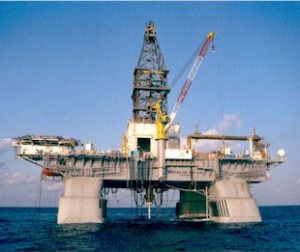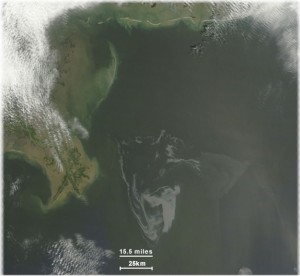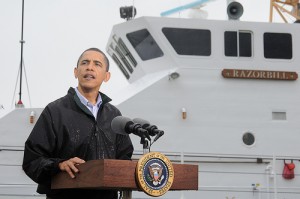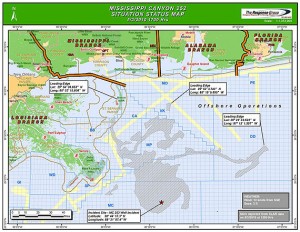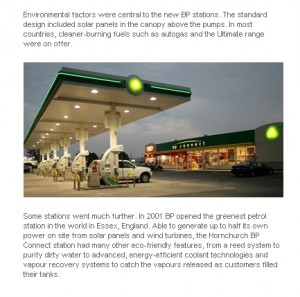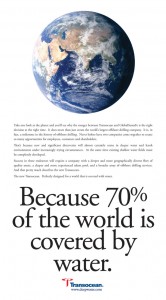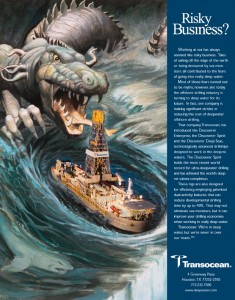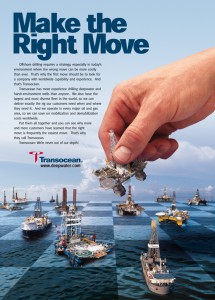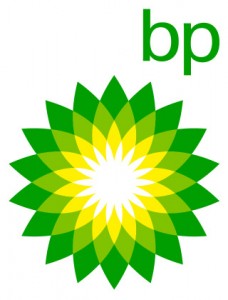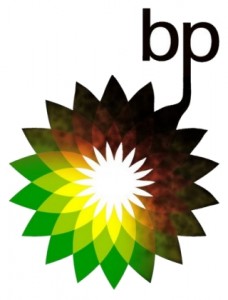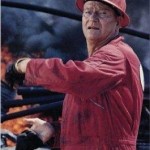Deepwater Disaster
LAST UPDATED: January 3, 2013
While an oil spill in the Gulf of Mexico might not have gotten much concern from some New England residents, in the coming months the effects of the explosion and subsequent oil spill at the site of the Deepwater Horizon oil drilling platform may have lasting effects across the country -- and beyond.
An estimated 70% of all North American waterfowl species use the area and many North and South American songbird species rest or feed in the area on their annual migration routes across the Gulf.
Shrimp, crab and fish catches from the Louisiana fishing fleet have already been affected.
Early on the event was shaping up to be a major ecological disaster -- it could end up causing severe long term ecological damage to the fisheries, nesting grounds and the eco-sensitive Gulf coast. Hotel and tour operators in surrounding areas are already experiencing cancellations from tourist who do not want toswim or fish in the Gulf.
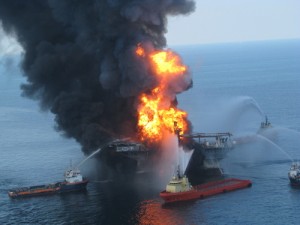
Fire boat response crews battle the blazing remnants of the off shore oil rig Deepwater Horizon April 21, 2010. A Coast Guard MH-65C dolphin rescue helicopter and crew document the fire aboard the mobile offshore drilling unit Deepwater Horizon, while searching for survivors April 21, 2010. Multiple Coast Guard helicopters, planes and cutters responded to rescue the Deepwater Horizon (photo courtesy, U.S. Coast Guard)
Deepwater Horizon: Disaster Timeline
April 20, 2010 - at approximately 10:00 pm BP's massive off-shore oil rig "Deepwater Horizon" explodes at sea approximately 48 miles off the coast of Louisiana. 11 workers missing and feared dead, 17 injured. Immediate thoughts are for missing workers. Rescue efforts begin.
April 24, 2010 - more than three days have passed since the rig exploded and Coast Guard rescue efforts end. The 11 missing worker are presumed dead. The mission turns to oil containment and cleanup efforts as an estimated 1,000 barrels of oil a day are leaking from the uncapped well.
At first it was reported that no major amounts of oil were leaking at the well which is in the Macondo Prospect, an undersea oil field which lies 5,000 feet below the surface approximately 50 miles off the coast of Louisiana.
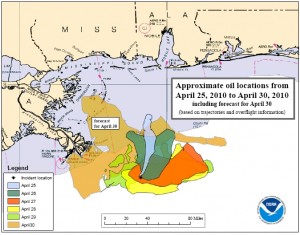
NOAA predictions of spread of oil from well explosion in Gulf of Mexico, April 25-30, 2010, (based on winds, currents and known oil dispersal properties)
April 25, 2010 - NOAA, (the National Oceanic and Atmospheric Administration), is tracking the slick which has been spreading from the drilling site. Onshore winds from the south are driving the slick towards sensitive migratory bird and waterfowl breeding grounds and other environmentally sensitive coastal areas.
Parts of the oil slick are lit afire sending a plume of noxious black smoke into the air.
April 28, 2010 - "2010 Offshore Industry Safety Awards Postponed". The Department of the Interior’s Minerals Management Service (MMS) announces "the 2010 Annual Industry SAFE Awards Luncheon scheduled for May 3, 2010 at the Offshore Technology Conference (OTC) in Houston, Texas has been postponed." The press release goes on to say, "The ongoing situation with the Transocean Deepwater Horizon drilling accident has caused the MMS to dedicate considerable resources to the successful resolution of this event, which will conflict with holding this ceremony next week." and then offers it's apologizes "for any inconvenience" and thanks the organizers of the OTC for their understanding.
April 29, 2010 - U.S. Secretary of Homeland Security Nancy Napolitano gives press conference explaining how the uncapped well beneath the exploded rig is pouring an estimated 5,000 barrels of oil a day into the Gulf of Mexico and that the US Military is assisting BP in assessment and containment operations. Napolitano stresses that BP will be paying for all costs.
April 30, 2010 - The oil slick has spread and now covers over one hundred square miles of ocean. The slick first hits land in the breeding area of the Brown Pelican, (Louisiana's state bird which only recently made enough of a comeback to be taken off the EPA's endangered species list).
"[This] may become the worst environmental disaster in American history".
- Carl Pope, Chairman, Sierra Club, April 30, 2010
Florida Governor Charlie Crist declares State of Emergency in coastal affected counties in response to oil slick which is spreading towards the state.
Officials express concern that BP is not prepared to stop or clean up a spill of this magnitude which has poured somewhere between 1.5 and 8 or 9 million gallons of oil into the Gulf of Mexico in the past 10 days -- depending on who's numbers you use; the oil company's, the government's, or calculations by Ian MacDonald, a Florida State University oceanography professor).
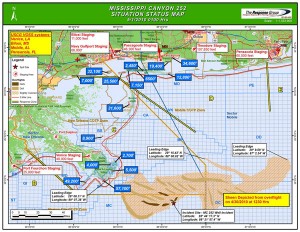
Deepwater Horizon Situation Map for May 1, 2010 shows placement of oil containment booms and staging areas along US Gulf Coast.
May 1, 2010 - BP increases response to cleanup, offers local boat owners and others work dispersing booms, handling equipment in staging areas. National, regional and local environmental groups organize volunteers.
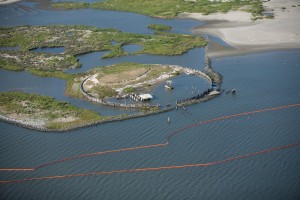
Booms to stop oil from Deepwater Horizon spill set near bird sanctuary, Breton National Wildlife Refuge, near Venice, La
May 2, 2010 - NOAA restricts fishing in the Gulf of Mexico from the mouth of the Mississippi River to Pensacola Bay in Florida. The fishing ban will be in effect for a minimum of ten days.
President Barack Obama travels to Gulf of Mexico to see Deepwater Horizon spill area, get first-hand situation reports for command centers, and addresses Coast Guard and media in Venice Louisiana waterfront press conference.
May 3, 2010 - May 3, 2010 - Attorney Generals from Lousiana, Florida, Mississippi, Alabama and Texas meet in Mobile to discuss legal aspects of the Deepwater Horizon spill. At virtually the same time, organizers of the 2010 Offshore Technology Conference, (OTC), announce that a topical luncheon called "The Challenges and Rewards in Operating in the World's Offshore Basins" which was to be hosted by Andy Inglis, (Chief Executive, Exploration and Production at BP), which was scheduled for today has been canceled.
BP "Situation Status Map" (below) shows booms in place and no oil near coastline. BP "Response Group" information appears to have the job of painting a pretty picture of the spill area and making it appear everything is under control.
The next day's NOAA trajectory map show something different...
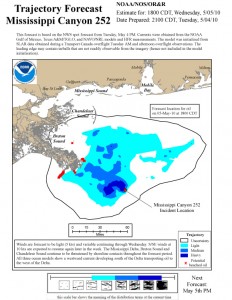
May 4, 2010 - NOAA 24 hour trajectory map predicts oil hitting sensitive coastal breeding and wildlife refuge areas.
May 4, 2010 - approximately thirty sea turtles wash up on the shore, dead. Head of National Wildlife Federation observes sea-turtles swimming in the edge of the oil slick. Dead and live but "oiled" birds are showing up. Proctor & Gamble donates 1000 bottles of its Dawn™ liquid dish detergent which is used to clean oiled wildlife. According to information on Dawn's website, "Animal rescue organizations choose Dawn because it removes the greasy oil—while being gentle on delicate feathers and skin." The company has been involved in oil-spill related animal rescues and clean-ups for over 30 years.
Proctor & Gamble may be one of the only major corporations involved in the disaster to come up smelling clean, (and oil-free).
While most are focusing on how to stop the flow of oil and clean up what has already leaked, others are looking into why the explosion and spill occurred in the first place.
Numerous class action lawsuits have already been filed, and most likely more will come. In these types of situations, parts vendors, materials suppliers and any other individual or corporation involved in the spill may find themselves being sued.
So far the Deepwater Horizon incident involves three major corporations:
- Transocean - Houston, TX based builder / owner of the Deepwater Horizon oil rig.
- BP, LLC - formerly known as British Petroleum, the company, was re-branded as Beyond Petroleum in 200o, but is commonly known simply as "BP". It is the 4th largest corporation in the world and operates BP gasoline stations and other petro-chemical operations around the globe. BP is currently leasing the Deepwater Horizon rig from Transocean to drill BP wells in the Gulf of Mexico.
- Halliburton - contractor providing a service called "cementing". Work is performed only 20 hours before explosion.
Much speculation has surrounded work done at the site by Halliburton, the Houston, TX based global energy equipment service company headed by former Vice President Dick Cheney until he was elected to office. Cause for almost half of the 39 oil rig blowouts in the Gulf of Mexico in recent history have been attributed to cementing issues.
While a certain outspoken ex-Governor from Alaska thinks we should "Drill, baby drill!", others aren't so sure. This week President Obama suspended all new off-shore oil lease sales.
Text and photos on BP's website boast of the "greenest petrol station in the world". Now there's an oxymoron. BP put solar panels, water conservation and renewable resources into a single building designed to sell coffee, candy bars, and collect cash from all the customers as they pump gasoline into cars and trucks... maybe that's what they mean by "green"?
The off-shore oil industry would like you to think drilling for more oil is the way out of the global energy our shortages many are predicting -- and that they can be green enough and clean enough to compete with renewable, (non-petroleum based), energy sources.
It's almost amazing how far these corporations will go to protect and expand their market.
|
Below is an ad posted on Transocean's website regarding the formation of the largest offshore drilling company in the world. The ad suggests that because the Earth is covered 70% by water, we should allow them (Transocean) to drill offshore as much as possible. The ad is rendered in an "eco friendly" format but has a clear pro-petroleum message.Big Oil Glossary: blowout - in oil drilling terms, a well is said to "blow out" when uncontrolled oil escapes from the well. Blow-outs are more than simple leaks or spills, they are high pressure releases caused by subterranean pressure compounded by the expansion of gasses as they reach the surface. BOP - blow-out preventer BOP stack - a pipe like configuration of several blowout preventers stacked one atop another to act as a fail-safe redundant system to prevent the possibility of well blow-out. cementing - process of securing a nested series of pipes into place on an oil well head through which oil, mud, water, gasses and even the drill itself can pass through the surface into the liquid oil reserves. "Cementing" also describe process of plugging exploratory holes which have been drilled and abandoned. "top kill" - process of pumping heavy drilling mud, into a well to stop the flow of oil, concrete is then pumped in to seal the well shut. "junk shot" - the process of injecting tons of shredded golf balls, recycled plastics and other junk into an out of control well to slow or stop the flow of oil -- BP tried this and it failed too. |
The Transocean ad (above) titled "Risky Business" ends saying "We're in deep water, but we're never in over our heads."The next Transocean ad "Make the Right Move" ends saying "We're never out of our depths." |
In 1989 the Exxon Valdez grounding spilled 11 million gallons of oil into Alaska's Prince William Sound. Hundreds of thousands of seabirds, thousands of otters as well as hundreds of harbor seals and bald eagles were killed -- along with 22 orca whales. Salmon and herring fisheries were devastated, and the effects on the area are still noticeable today -- over 20 years after the spill.
All reports indicate the Deepwater Horizon spill will continue gushing oil into the Gulf for anywhere from a few weeks to two months or more. It could easily surpass the volume of oil spilled, and the severity of ecological damage caused by Exxon Valdez.
Engineers have begun work to fabricate a cap for the well which will need to then be installed with deep waters and leaking oil promising to make it a difficult operation.
Faced with such environmental damage -- or even the risk of it --- ideas like Cape Winds, (an ocean based wind farm planned for Nantucket Sound off the south coast of Cape Cod), sound a little better when compared to potential annihilation of birds, fish, sea animals and coastal environments.
========================================
UPDATED: May 6, 2010 - a custom fabricated 100-ton concrete and steel cofferdam is loaded onto a barge destined for the Deepwater Horizon site. The disaster response team intends to lower the "big box" over the leaking pipework and route the oil up into containment vessels.
The U.S. Coast Guard reports oil has hit land in the eco-sensitive barrier islands south of New Orleans.
========================================
UPDATED: May 10, 2010 - the 100 tone cofferdam failed when ice crystals clogged the structure and threatened to cause more damage and possibly open the leaks releasing even more oil into the Gulf.
Estimates of approximately 3.5 million gallons of oil have (so far) been spilled into the Gulf of Mexico.
BP LLC shareholder files lawsuit against the British owned oil giant, (NYSE:BP), claiming the company has repeatedly ignored safety concerns citing little change in practice since previous major spills and fatal accidents. The suit alleges the company spends money lobbying politicians to get safety and environmental regulations eased to increase corporate profits and does so knowing they are endangering people and wildlife.
BP stock is off roughly 20% since a recent mid-April high of $62, closing 5/10/2010 at $49 and change.
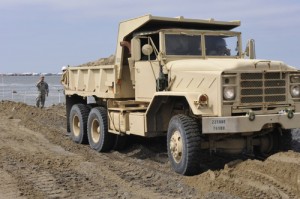
EDEN ISLAND, La. - Louisiana National Guard soldiers transfer sand to close an inlet by Eden Island May 10, 2010. Inlets off Eden Island are being closed in an effort to keep oil from the Deepwater Horizon incident from damaging inland waters. U.S. Coast Guard photo by Petty Officer 3rd Class Barry Bena.
The U.S. Coast Guard (USCG) and Minerals Management Service (MMS) begin a joint fact finding investigation to, "identify the factors leading to the explosion, loss of life, sinking, and subsequent oil spill of the Deepwater Horizon Mobile Offshore Drilling Unit." The first witnesses to be called 5/11/2010 are USCG and MMS personnel.
========================================
UPDATED: May 11, 2010 - congressional hearings bring BP, Transovean and Haliburton execs in from the lawmakers who get no straight answers from any of the execs -- all pointing fingers at each other and none assuming responsibility. Congressmen accuse BP of "making it as the go" in regards to the proposed solutions and clean up efforts.
========================================
UPDATED: May 13, 2010 - BP trying a new approach -- inserting a smaller pipe inside the one that is leaking, then capturing the leaking oil into storage vessels.
========================================
UPDATED: May 14, 2010 - after viewing BP released underwater video of the leak, and using a formula for mearing liquids in motion, a Stephen Werely, a professor of mechanical engineering at Purdue University calculates that the leak is sending 70,000 barrels, (2,940,000 gallons), per day into the Gulf of Mexico, not the 5,000 barrels, (210,000 gallons), estimated by BP.
Head of BP, Tony Hayward downplays the spill and call it "tiny", saying "The Gulf of Mexico is a very big ocean ... the amount of oil and dispersant we are putting into it is tiny in relation to the water volume."
========================================
UPDATED: May 16, 2010 - Mike Williams, a crew member and the chief electronics technician in charge of Deepwater Horizon's computers and electronics gives a whistleblower interview to CBS "60 Minutes". Williams was aboard the rig when it exploded -- and was one of the last to get off alive. He described how BP was weeks behind on the $1Million a day drilling operation and how the company pushed workers to drill faster and get the well producing profit -- even though safety equipment that could have prevented the blow-out were damaged, and other parts of the back-up safety equipment was non-functional. Williams described weeks of incidents including chunks of damaged rubber seals that had come up the pipe and been reported to management -- the chunks were parts of the blow-out preventer, ("BOP"), which failed. Williams further detailed how BP and Transocean heads of operations on the rig had argued about possible signs the well was in trouble only 11 hours before it exploded.
AP reports Deepwater Horizon "monthly" inspections occurred only 48 of the past 64 months, (nearly 25% of the mandated inspections were never performed). Further, the agency responsible for the inspections, the US Minerals Management Service, ended up giving Deepwater Horizon a Safety Award for 2009 citing only (1) minor infraction had occurred. Many question the close ties between the oil industry, their lobbyists, politicians and the MMS.
========================================
UPDATED: May 20, 2010
(1) MONTH SINCE DEEPWATER HORIZON EXPLODED!
Today, BP is collecting 5,000 barrels of oil a day from the ruptured pipe and sypohning it up a 1 mile long tube into a waiting tanker. While some see the process of collecting some of the oil as "progress" -- others wonder why BP doesn't just pump concrete into the well and plug it up, or dump tons of concrete on top and cap it. Some question if BP's motive is to keep tapping the oil flow for profit as they work out a repair operation rather than losing all of their investment and stopping the flow -- after all, it is a "gusher".
For most of the month BP has alleged the total amount of oil spilling in to the Gulf at 5,000 barrels, (210,000 gallons), but since they are now only capturing some of the leak, the number show what most beleived -- the leak is gushing much more oil than BP claimed.
Almost 20,000 individual claims have been filed against BP for losses by individuals, businesses and Government offices. BP has already paid half the claims.
Louisiana, Governor Bobby Jindal said the wetlands in the Pass a Loutre area of Plaquemines Parish have been hit with heavy oil. NOAA reports a thin layer of oil is in the Gulf's "Loop Current" which flows out around the Florida Keys and will spread oil into the Atlantic Ocean, possibly washing up on east coast beaches.
========================================
UPDATED: May 27, 2010 - in a news conference President Obama says he will take personal responsability to make sure that BP, the Federal Government and anyone else involved does everything possible to prevent further environmental damage, saying he [wrongly] took the word of the oil industry when [it] claimed it "knew what it was doing" [but obviously did not]. He goes on to explain that the U.S. Government "does not posses superior technology" [to BP or the oil industry which would allow the government to do a better job at capping the well and cleaning up the mess].
President Obama declares a 6-month moratorium on offshore oil contracts and begins investigations to formalize new rules and regulations to prevent future incidents.
Elizabeth Birnbaum, Director of the U.S. Dept. of Interior, Minerals Management Service, (MMS), resigns. Birnbaum had only been on the job since July 2009, (less than a year). Prior to that she had been with the American Rivers conservation group. Prior to Birnbaum's appointment, MMS has been more of a "M-E-S-S". The Bush/Cheney Whitehouse had let the agency run wild, as an article in the New York Times titled, "Sex, Drug Use and Graft Cited in Interior Department", (by Charlie Savage published September 10, 2008), which notes, in-part; "...The reports portray a dysfunctional organization that has been riddled with conflicts of interest, unprofessional behavior and a free-for-all atmosphere for much of the Bush administration’s watch." Regardless, Elizabeth Birnbaum was probably not well equipped to deal with the gun toting cowboys that wrangle deals at MMS, and likely realized it. It was leaked that she was asked to resign -- and offered to work in some other capacity, but all that is definite is that she resigned. U.S. Secretary of the Interior, Ken Salazar, (Elizabeth Birnbaum's boss), plans to divide MMS into two or three divisions. One to manage leases. One to oversee oil drilling, and possibly other divisions. Currently the agency sell leases and does the inspections of oil drilling operations on the same properties -- which creates an "appearance of conflict(s) of interest". Elizabeth Birnbaum's only fault -- she didn't do anything.
========================================
UPDATED: May 28, 2010 - For the past 2 days BP has been beginning the "top kill" procedure where they pump heavy drilling mud down 1 mile to the ocean floor, then pump it into the 3-mile deep well shaft is blowing out oil into the Gulf. Overnight BP did a "junk shot" which amounts to pumping shredded tires, golf balls and other junk down the well to jam it up. If the mud and junk manage to hold back the oil, the final step in the "top kill" is to pump concrete down the well to permanently plug it.
Today President Obama flys to the Gulf again for a hands-on personal inspection of the environmental damage and clean-up efforts.
Latest reports indicate as much as 5 times the amount of oil ever calculated from the leak is a more likely estimate, and that as much as 39 Million Gallons may have poured into the waters.
A second oil plume is detected near the ocean floor. The plume is estimates to be 6 miles wide and 30 miles long and is the result of a chemical reaction of oil dispersant mixed with the heavy crude that is keeping it down, while other oil is floating at the top of the Gulf. Oceanographers and marine biologists fear the oil will sink and coat some of the most fertile deep-water fish spawning areas affecting the entire marine food chain.
As of today's estimates, Deepwater Horizon is 3 times as bad a spill as Exxon Valdez.
========================================
UPDATED: May 30, 2010 - BP declares "top kill" attempt a failure, oil continues to gush into gulf.
On CBS's "Face the Nation", when asked if he believes BP has been lying to the government, Massachusetts Rep. Ed Markey (D), Chairman of the House Subcommittee on Energy and Environment replies "I think they're either lying or incompetent -- either way, the consequences to the Gulf of Mexico are catastrophic." Markey went on to explain that the U.S. Government could bring criinal charges against BP, and fine them billions of dollars. The focus of the criminal complaints are; lying to the government, (in regards to obtaining the drilling lease in the first place and certifying they could manage the site), and additionally since environmental damages are fined against the number of gallons spilled, BP could have more the "Public Relations" reasons for wanting to hide the true damage, (which is estimated to be somewhere between 20 and 40 million gallons as of today).
BP's next attempt to stop the flow involves using submersible robots to cut the leaking pipe cleanly off, and install some sort of valving that may allow them to turn off the flow.
Creative artists have been waging a media war against BP, claiming the company moniker now stands for "beyond polution" (rather than "Beyond Petroleum" as the BP slogan).
The sunny green logo has gotten fair treatment to, with a bit of a stain on the company's attempt to paint itself eco-friendly.
========================================
UPDATED: June 3, 2010 - BP's latest attempts to cap the well are not going smoothly. A diamond saw that was being used to cut through the leaking pipe got stuck and failed. A shear had to be used to cut the pipe which creates a rougher cut and will make fitting any type of cap to the riser pipe more difficult. President Obama plans 3r trip to Gulf coast in recent weeks as oil begins washing up on more beaches and the immensity of the spill and looming ecological disaster becomes more apparent.
Facts about poor oversight at MMS and "exemptions" which allowed the BP to get a permot for the Deepwater Horizon site issued with no environmental impact reports are coming to light. Obama administration is trying to get a handle on all offshore drilling and has issued a moratorium on new and previously approved permits for offshore drilling over 500 feet. Only wells already producing may remain in production -- other wells have been shut down even where drilling had already begun.
========================================
UPDATED: June 20, 2010 - Two Months into the Disaster the well is still gushing oil into the Gulf. Fisheries are closed, tourism is off, a drilling moratorium is in place, and tens of thousands who make their living on the water watch as their lives disintegrate under slick BP oil. One fisherman reportedly attempts suicide.
BP's CEO, Tony Hayward, decides to reduce his own personal stress by spending the day with his family racing their 52 foot yacht "Bob" in the JP Morgan Asset Management "Round the Island Race", (off the Isle of Wight).
As the numbers, or estimates, or guesses, or lies keep changing, what began as an estimated "1000 barrels a day", then 5,000; then 10-20,000 has now been estimated at 60,000 barrels a day -- equal to an "Exxon Valdez size spill" every three days.
Oil is washing up on beaches. Dead and oiled sea animals are too. Politicians are milking the disaster for personal or party gain. BP has agreed to paying for a $20 billion fund to be administered by a 3rd party and pay claims to those affected by the spill.
BP is collecting some of the oil from the leak and drilling a relief well to get it all. Many think the entire time the oil has been gushing, BP's only interest is in recouping profits from the Deepwater Horizon investment gone bad.
While politicians and those directly affected by the spill are all but silent, most New Englanders happily fill their gas tanks, are happy that gas prices are under $3.00/gallon, and hope prices stay low to heat their homes with oil this winter --- environmentalists and renewable energy proponents say this is the wake up call -- now all they need to do is fight big oil, (and the politicians who get their palms greased with oil money).
========================================
UPDATED: June 22, 2010 - U.S. District Court Judge Martin Feldmam, in the U.S. district Court of Lousiana grants a preliminary injunction in favor of Plaintiff Hornbeck Offshore Services LLC, suit againt U.S. Secty. Ken Salazar et al to have the 6-month offshore drilling moratorium overtunred. Judge Martin is a Regan appointee. The Obama administration announced they will appeal the decision as soon as it was issued. States along the Gulf of Mexico are dealing with a double-edge sword --- the moratorium hurst economically in states where many businesses depend on income from off-shore oil expolation, yet the oil leak also affects them economically and environmentally.
========================================
UPDATED: June 29, 2010 - at the hurricane season settles into the Gulf of Mexico, the season's for named storm "Alex" threatens to shut down erfforts to contain the spill. Governor Haley Barbour, (R-Miss.), backpedals after criticizing the Obama administration's moratorium on offshore oil drilling and downplaying damage from oil on beaches after oil starts washing up on Mississippi beaches later in the week. BP continues to fumble through its attempts to cap the gusher with an underwater robot knocking the temporary funnel-cap out of place and losing another days worth of oil into the Gulf. Estimates of the amount of oil leaking from the well continue to rise -- the only sure number is how many gallons a day they are capturing -- and while scientists and engineers can not put a firm number on how much oil is leaking and only estimate that BP is only collecting a fraction of it, the amount BP is capturing exceeds their estimates of the total amount leaking. Russian reports come out showing BP understated theri safety record in that country, claiming only (1) worked was killed on a BP rig, when actually between 14 and 30 deaths have occured. BP chose to not report the deaths, claiming they were on the Russian team that shares in the drilling operation -- even though all oil majors routinely list all deaths, including those involving partner or contractor fatalities. Documents are leaking from BP almost as fast as the Gulf well -- ones showing BP's cavalier attitude towards safety and their golas of expanding off-shore and deeper water wells. U.S. BP gas stations are feeling the wrath of motorists who are boycotting the companies stations. No end is in sight for the spill, and oil has affected beaches in four gulf coast states, (Florida panhadle, Loisianna, Mississippi and Alabama). Reports of oiled birds being secreted away by "BP" hires are unsubstantiated -- but demonstrate the total lack of trust in the company.
========================================
UPDATED: July 10, 2010 - BP announces they may be able to stop the flow of oil from leaking into the Gulf by Monday, (July 12, 2010), by placing a new cap over the blownout well -- the oil will gush freely into the Gulf for a short time while they fit the new cap, and then will be able to contain and capture 100% of the oil until the relief wells are completed.
Slicks of thick weathered oil have been washing up more regularaly along Gulf beaches. The fishing industry and oil drillign industries are all but devestated in the region.
An appeals Court has refused to uphold the Whitehouse's 6 month ban on off-shore drilling.
AP Reports estimated total amount of oil spilled since April 20th at somewhere between 90 and 170 million gallons -- either number is terrible.
========================================
July 15, 2010
The Day The Oil Stopped
After 107 days and gushing what some estimate may have been 250 million gallons of oil into the Gulf of Mexico, BP was finally able to stop the flow of oil from the well.
The sad part is, that's just the beginning of the ecological nightmare that could last decades. BP says its committed to staying in the Gulf and cleaning up the mess no matter the cost, but many are already complaining it is too little, too late.
The really sad part is, most Americans only felt a small twinge of guilt or pain over the spill -- knowing their dependence on oil endangered our small planet.
========================================
UPDATED: January 3, 2013 - The United States' Justice Department released a notice that "Transocean Agrees to Plead Guilty to Environmental Crime and Enter Civil Settlement to Resolve U.S. Clean Water Act Penalty Claims from Deepwater Horizon Incident", and went on to detail that Transocean has agreed to pay $1 Billion (US) in civil penalties and $400 Million (US) in criminal fines. This money is in addition to suits against BP, Anadarko Petroleum, Haliburton and other defendants. For details of agreement, see the U.S. Dept. of Justice announcement about the $1.4 Billion Penalty.
========================================
Maps, photos and informational resources:
- United States Coast Guard, (USCG), www.uscg.mil
- National Oceanic and Atmospheric Administration, (NOAA), www.noaa.gov
- National Air and Space Administration, (NASA), www.nasa.gov
- U.S. Fish and Wildlife Service, (USFWS), www.fws.gov
- *Minerals Management Service, (MMS), www.mms.gov
- *MMS is a bureau of the (US) Department of the Interior, (DOI), www.doi.gov
- BP, www.bp.com
- Transocean, www.transocean.com
- Halliburton, www.halliburton.com
- Internet Movie DataBase, (IMDB), www.imdb.com
###

